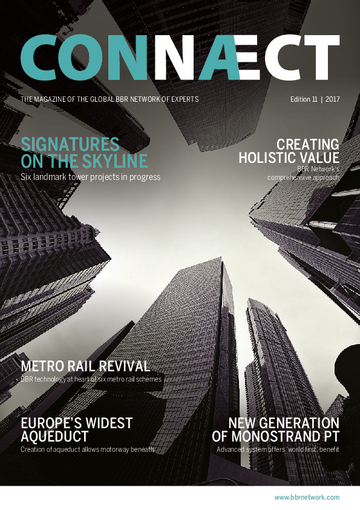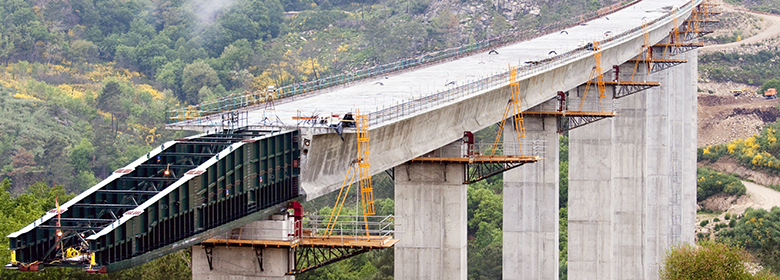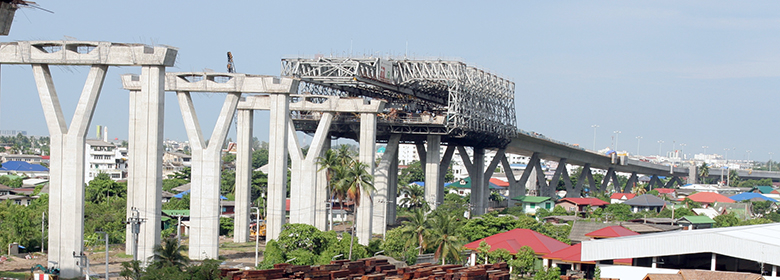Engineering excellence in bridge construction and heavy lifting
The BBR Network provides excellence in all categories of bridge construction techniques whether for cast-in-situ applications or precast construction. We offer the whole range of expertise from preliminary design to execution for balanced cantilever, incremental launching, advanced shoring (MSS), span-by-span techniques and related methods, and maintain a complete range of bridge construction equipment.
Balanced cantilever (cast-in-situ and precast)
The proven and safe balanced cantilever method, as used by the BBR Network, is often appropriate and cost-effective for the construction of long span concrete bridges including various landmark structures where height, topography or geotechnical conditions render the use of conventional formwork uneconomical.
Balanced cantilever is one of the most popular bridge construction methods used by BBR Network Members on all continents. The economical range of span lengths for cast-in-situ cantilever construction begins at roughly 70m and extends to beyond 250m. Considerable savings can be achieved by using this method rather than conventional bridge construction.
Free cantilevering is a method of construction where a structure is built outward from a fixed point to form a cantilever structure, without temporary support, using staged cast-in-situ construction. When two opposing free cantilever structures are attached as a single structure and erected in the same step, it is known as ‘balanced cantilever’.
In basic terms, cast-in-situ construction describes a process whereby segments are progressively cast on site in their final positions within the structure.
By comparison, for precast construction, the segments are prefabricated at a casting plant – either on site or at a remote facility – then transported to the project site and erected as a completed unit in their final positions.
Over the last 30 years, the BBR Network has successfully executed dozens of balanced cantilever projects – cast-in-situ and precast – all over the world. We have a proven record through all construction stages from preliminary design to execution and provide professional support to consultants, designers, owners and contractors.
Incremental launching
Incremental launching of bridges can save time, money, space and disruption while easing access and delivering a high quality finish.
The incremental launching method is particularly suited to the construction of continuous post-tensioned multi-span bridges. It involves casting 15-30m long sections of the bridge superstructure in a stationary formwork behind an abutment and pushing a completed section forward with jacks or friction launching system along the bridge axis. The sections are cast contiguously and then stressed together. The superstructure is launched over temporary sliding bearings on the piers. To keep the bending moment low in the superstructure during construction, a launching nose is attached to the front of the bridge deck.
The main advantages for using this construction methodology, rather than other traditional methods, are:
- Minimal disturbance to environmentally sensitive areas
- Smaller assembly zone required
- Greater safety during construction which is mainly carried out at ground level
- Economy of transportation and general reduction in construction elements
- Higher quality finish and performance derived from easier working conditions and repeatability of tasks
- Ease of access to restricted or limited sites – such as over rivers, deep valleys, road or train lines, in poor soil conditions or environmentally protected areas
Although its significant advantages make using this technique a highly attractive option, certain aspects require a high level of expertise – both in terms of people and equipment – offered by Members of the BBR Network. They have much experience, acquired over many years, in the techniques of incremental launching and a track record for successful delivery of launched structures all over the world.
Advanced shoring (Movable Scaffold System MSS)
The advanced shoring method – or Movable Scaffold System MSS – has been developed for multi-span bridges over difficult terrain or water where scaffolding would be expensive or simply not feasible. A launching girder moves forward on the bridge piers, span-by-span to allow placing of the cast-in-situ concrete. The method – both underslung and overhead – is highly adaptable for a wide range of spans and types of superstructure.
Conventional falsework or scaffold is a suitable choice for construction of single-span bridges. For bridges that are considerable longer and have multiple spans, the scaffolding needs to be moved between the different sections of the bridge during construction. This has developed the advanced shoring technique. The construction method uses a movable supporting beam, gantry, for the falsework that reaches over at least one span but usually over the length of two spans. With the supporting beam in place, transverse beams along the gantry secure the formwork and working platform and the building process can be carried out efficiently. With special roller bearings and launching jacks the gantry can easily be moved forward along the bridge as the construction proceeds. The travelling gantry system is most suited for spans of 30 to 60m.
Precast span-by-span
The precast span-by-span bridge construction method offers a very high speed of construction. It is most often used in conjunction with an erection truss under the bridge segments or an overhead erection gantry to guide the precast elements into position. The span-by-span construction technique consists of the following primary steps:
- Erecting the segments for the entire span onto a temporary erection girder spanning between a pair of adjacent permanent piers
- Installing and stressing longitudinal PT tendons enabling the segments to span on their own
- Advancing the erection girder into place to erect the adjacent span
Since there is only one cycle of stressing and grouting of tendons per span, the method can be significantly faster than precast balanced cantilever construction, which requires one such cycle per pair of segments.
The most common use of span-by-span construction is to build long viaducts with spans of similar length. The method has been used most often for spans ranging from 25m to 45m. As spans increase, there is a significant increase in the cost of the erection girder. Erection girder can support the segment from below, or above – underslung and overhead launching gantries.
Alternatively, full-span precast beams can be delivered from the precast beam production to the erection front by the launching gantry. This method allows a fast rate of erection.
Heavy Lifting
Heavy lifting is a specialist hydraulic cable lifting technique developed for exceptionally heavy loads and used by BBR Network Members. The technique provides a particularly timely and economic solution for projects based on modular construction methods and large, heavy, pre-fabricated elements. The heavy lifting technique can be used for:
- Lifting and lowering of heavy loads – precast beams, entire structural elements, roofs, falsework etc. built on site or at a factory are lifted in place by means of strands and hydraulic jacks
- Lifting of bridges – for the exchange or repair of bridge bearings for instance, the superstructure is lifted and lowered with hydraulic jacks without disturbing traffic
- Rotating and sliding of bridges – bridge structures can be rotated or slid from the assembly area to its final position
Typical bridge span ranges
- Conventional falsework: up to 80 m
- Precast segmental span-by-span:
25 - 45 m - Precast balanced cantilever:
45 - 135 m - Cast in-situ balanced cantilever:
70 - 250 m - Launching: 30 - 60 m
- Arch (precast and cast in-situ balanced cantilever): 50 - 200 m
- Cable-stayed (precast and cast in-situ segments): 150 - 700 m
Get in touch with us

Click here to see our worldwide locations.
CONNÆCT 2017

Eleventh Edition of the Magazine of the Global BBR Network of Experts
See our Downloads pageThe right method
The bridge construction method plays a significant role and should be considered during the preliminary design period, with the help of the BBR Network. The construction method depends mainly on topography and influences bridge cross-section design as well as span. Basically, four major techniques, such as balanced cantilever, advanced shoring, launching and span-by-span, are employed, along with conventional falsework or bridge heavy lifting operations. In addition, a wide range of different or adapted methods are used.












